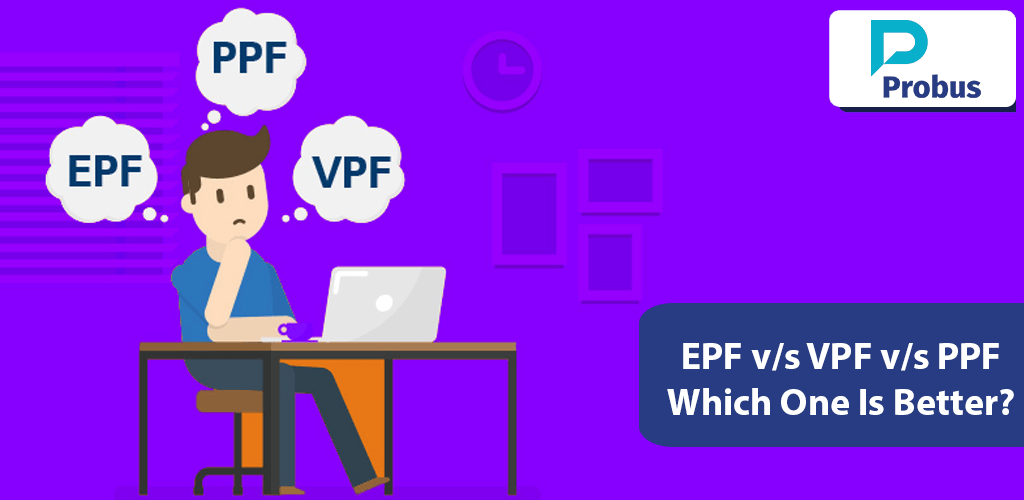Young working professionals are becoming more and more aware of the significance of retirement planning. But it has become challenging for them to choose which investment option is the best for them, given the abundance of options on the market.
In such a situation, people can choose low-risk products such as the Employee Provident Fund (EPF), Personal Provident Fund (PPF), and Voluntary Provident Fund (VPF). These investments are perfect for long-term objectives like retirement planning because they are extremely secure and provide predictable returns. You can choose the finest option by being aware of the distinctions between the three.
What Is Meant By EPF, VPF, & PPF?
EPF (Employee Provident Fund)
Under Employee Provident Fund, employees are required to make a mandatory monthly contribution equal to a portion of their salaries. Keep in mind that employers are also required to contribute on a percentage basis. Additionally, organizations with more than 20 employees must participate in this plan. The plan’s creators envisioned it giving all employees long-term stability and financial security. The money saved can be deducted from taxes and earns interest. EPF is a risk-free investing choice as well.
VPF (Voluntary Provident Fund)
In the case of Voluntary Provident Fund, employees may voluntarily contribute any amount of their wages to their individual Provident Fund accounts. This contribution needs to be more than 12%. These days, it may even be the full base pay and dearness allowance. The employer is not required to pay into the VPF, though. The total sum will be credited to EPF accounts at the same interest rate as EPF.
PPF (Personal Provident Fund)
PPF is a government-guaranteed fixed income security option that can be used to structure retirement portfolios for people who are self-employed or do not receive a salary. To receive risk-free and guaranteed returns, anyone, however, can make a contribution to a PPF account. You will receive interest on the interest earned in addition to interest on the amount invested. The accumulating balance is also tax-free.
What Is The Difference Between EPF, VPF, & PPF?
Based on the following parameters, let’s discuss the difference between EPF, VPF, and PPF.
| Parameters | EPF | VPF | PPF |
| Contribution | The minimum EPF contribution for both the employee and the employer is 12% of the employee’s basic income plus their dearness allowance. | An employee’s contribution to a VPF can be any amount up to 100% of their pay plus a dearness allowance. | PPF contributions are optional and are limited to Rs. 1.5 lakhs each year. |
| Returns | Both the VPF and the EPF offer interest rates that are currently 8.55 percent. | The current interest rate of PPF provided by banks is 8%. The interest rate frequently fluctuates because the yield on 10-year government bonds affects the interest earned on PPF investments. | |
| Eligibility | Only those who are paid a salary can take advantage of the VPS and EPF programs. Any sum beyond the required 12% can be given by VPF members and will be added to the EPF account. | Non-salaried employees from the unorganized sector are eligible to create a PPF account at a bank or post office | |
| Investment Period | The accounts for EPF and VPF remains open until your retirement or resignation. The account can be moved to a new employer if you change jobs. | The Public Provident Fund, or PPF, has a 15-year investment duration. You have the option to extend it in 5-year increments once this time period has ended. | |
| Withdrawal Facility | EPFO permits withdrawal of 90% of the EPF corpus 1 year before retirement, provided the person is not below 54 years old. | A VPF account’s funds can be easily and completely withdrawn. Additionally, if a withdrawal from the VPF account occurs before the employee has worked for the firm for five years, the money will be taxed. | PPF accounts must be kept open for at least 15 years. It is only possible to withdraw a portion of your money, with some restrictions. The account may also be extended for an additional five years. |
| Loan Facility | When we talk about EPF and VPF, you can apply for loans up to 100 percent of your balance. | You can obtain a loan using PPF as collateral. After three years of investment, you can take out your first loan, and by the end of the second year, you can borrow up to 25% of the remaining money. Before the sixth financial year of your investment is over, you can also take out a second loan. However, you can only apply for the second loan once you have paid off the first one. | |
| Tax Reductions | If an employee has worked for the employer for at least five years, they are eligible for tax-free earnings on even the proceeds from EPF and VPF maturity. Any withdrawal made prior to five years is subject to taxation. | Your PPF investment will generate tax-free returns. | |
Points To Remember While Investing In EPF, VPF, & PPF
To maximize the advantage of your contributions, you should take into account the following factors in addition to the differences between VPF, EPF, and PPF.
- Since the yield on 10-year government bonds determines the PPF interest rate, returns may fluctuate depending on the market. EPF and VPF interest rates, however, are not correlated with government-yield bonds.
- People can open a PPF account at a bank or a post office to contribute to the Public Provident Fund.
- The maturity proceeds from the EPF and VPF are tax-free for employees who have worked for the company for five years straight. The fact that PPF returns are tax-free is one of the main distinctions between the two investment vehicles.
Making The Decision
The individual’s investment horizon and return expectations will influence their decision between PPF, EPF, and VPF. The comparison of EPF, VPF, and PPF provided above provides clear guidance on the best investment strategy for maximizing security after retirement.
You must contribute to the EPF if you are a salaried employee at a company with 20 or more employees. However, you should definitely take VPF and PPF into consideration if you want to build your retirement portfolio. You can choose any top bank in India to open a PPF account online because the majority of them provide this service.








